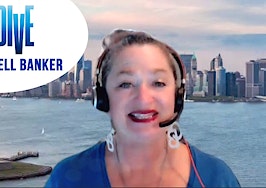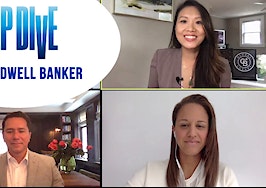This post was last updated Oct. 5, 2021.
Instagram is the perfect social media platform for real estate. There’s plenty of opportunities to make followers ogle at property photos, fall in love with listings through innovative IG stories and get a sneak peek into your day-to-day business through IGTV. So, why aren’t half of real estate agents regularly using the platform?

Chris Smith
According to co-founder of Curaytor, a real estate-focused digital marketing firm, Chris Smith, Instagram mystifies most agents who are used to the rules and etiquette of other platforms, such as Facebook and Twitter. Smith says they fail to realize that Instagram thrives on visuals and storytelling, not one-off statuses or links.
“Instagram is sort of becoming the internet,” he said. “At a recent conference, someone said, ‘Facebook is Google, and Instagram is Google Images.’ That’s the new internet, and that’s where people start now.”
Smith sat down with Inman and shared the five most common mistakes agents make on Instagram in 2021 and how they can fix them.
Mistake No. 1: Putting all of your eggs in the Instagram basket
Agents’ Instagram use has increased 13 percent since 2019, thanks to the platform’s growing popularity beyond millennials and Gen-Zers and a consistent rollout of new features. However, Monday’s outage struck fear in millions of entrepreneurs — including real estate agents — whose marketing strategy almost entirely depends on Facebook and Instagram.
“The first lesson that comes to mind is even if you’re a multibillion-dollar company, you can still mess up,” Smith said. “I also think it’s crazy impressive to have 2 billion daily active users, and even if you like crash once a year, I personally think that’s really good.”
“I think the other thing [the outage] probably did for people just give them a quick wakeup check, like, ‘Oh, I’m all in on Facebook or I’m only using Facebook and Instagram,” he added. “Many people didn’t have that third place to go.”
Smith said agents need to work on strengthening their website traffic and email database, which is less susceptible to widespread outages like the one Facebook and its companies experienced.
“The only thing you own online is your email list and the content that you create on your own website. The blogs you write and the emails you send are social media platform agnostic,” he added. “[Curaytor] gets 10,000 people to open an email when we send it. So on a day, like yesterday, if we still wanted to reach a bunch of people, we would just send an email.”
In addition to weatherproofing your digital presence by being on multiple platforms, Smith said having a solid website and email list means you can quickly spin negative events into positives for your business.
“I saw something yesterday that was really cool. One of my employees shared an email newsletter she received, and it basically said Instagram is down, so do this instead,” he said. “I thought that was really smart to execute that quickly against that trend. It’s called newsjacking — taking real-time trends and piggybacking them.”
“If I was Zillow, I would’ve sent an email yesterday that said, ‘Instagram is down, but Zillow isn’t, so come look at houses for a couple of hours,” he added. “I think Realtors could have done something similar if they were prepared.”
Mistake No. 2: Using shortened links in your biography bar
Smith says linked posts are the least likely to get engagement on all social media platforms because links pull users away from their timelines and to another site. This is especially true on Instagram because the platform’s purpose is to share photos and videos — not links.
“Links are not the preferred thing for social networks,” he noted. “These platforms want people to stay on their platforms, and they have to strike a balance between keeping traffic on their site and making it profitable for advertisers and marketers to use their site.”
Smith says agents are used to pushing links to listings and websites, which makes Instagram challenging to use because there are only two places for this kind of information: in the biography section or Instagram Stories.
Placing links in the biography bar isn’t particularly effective, especially if you’re posting a link to a single website or listing.
Furthermore, it’s difficult to call attention to that link without taking a hit to your engagement. Smith says Instagram has recently been “squashing” the reach of posts “Link in bio or #linkinbio” in the captions.
“But, [Instagram] has created an environment where marketing people are trying to come up with workarounds to turn a place that’s not really about links into [a place about] links,” he said.

Linktr.ee’s interface. | Credit: Linktr.ee
Smith suggests agents ditch bit.ly or other link shorteners and look into “Insta-sites” from platforms such as linktr.ee, Buffer and Milkshake. With these Insta-sites, agents can share multiple links to their brokerage website, their blog, their other social media accounts and specific listings all through a single, customizable link.
“You can also have all of your other stuff that’s important there, and you never have to change the settings on Instagram,” he said of flash websites. “You change the settings within those tools.”
Although flash websites are effective, Smith said two other options get better engagement and drive traffic to your website. The best place to get engagement for links is in Instagram Stories, where verified users with more than 10,000 followers can use link stickers, which replaced the swipe-up feature in August.
Another option is creating an “Insta-site” on your domain. “What I’ve seen a lot of our clients do, that I think is really clever, is basically replicating what those [flash websites] do, but then doing it on their own domain,” Smith said. “As an example, your URL could be alexandjoe.com/IG, and on that particular page, you’d have six or seven buttons that lead to content, just like all these other tools do.”
Smith says link features should be used purposefully, with the majority of your Instagram content living on the app itself. “Don’t be overly reliant on the ‘link in the bio’ call to action,” he said. “Eighty to 90 percent of the stuff that you put on Instagram shouldn’t require a link to get to it.”
Mistake No. 3: Using Instagram Stories like a tweet or Facebook post
Smith says many agents are using the Instagram Stories feature, but they fail to get engagement because they’re using the feature like a “tweet or a Facebook post” where they can share individual photos or videos that don’t necessarily connect.
“Where most people screw up is [thinking] a bunch of individual stories make a story,” he said. “Part of the reason people click through is that there’s no logic or thoughtfulness in what they’re sharing.”
“So, if you actually tell a story the way stories work — where they’re multilayered, and they have heroes and villains, and beginnings and endings; people will pay attention,” he added.
Instead, agents must build up to their request — whether it’s swiping up to click a link, leaving a reply or sharing the story with their audience. If agents make a request within the first post, Smith says your posts will likely receive a click rate of 5-10 percent.
“But if we build up to that request, and we have a story and another story, and then say, ‘click the link,’ we might get up to 30-40 percent of the people to do it,” he said.
“Gary Vee [Gary Vaynerchuk] has a very popular book that’s called, Jab, Jab, Jab, Right Hook. What most people are doing is just a right hook, and they’re not setting it up with a jab, jab, jab, then ‘boom’ [with a] link sticker.”
Smith said agents need to utilize other Instagram Story features, such as stickers, polls, and multiple-choice quizzes, along with photos and videos, to drive more engagement.
“The hack for stories is the content that performs the best is polls. It can be any kind of quick, simple and interesting question,” he said. “I always ask about real estate and marketing, like ‘Have you ever run a YouTube ad?’ or other questions related to my niche.”
“What I found is that when your first story is a poll and a lot of people take the poll, it amplifies that story to being seen by five, six times more people because Instagram is picking up on that high engagement rate,” he added.
Lastly, Smith also suggests agents play with the reels feature, which is similar to TikTok’s video format.
“Not enough people are using them; they’re kind of a little bit afraid of them,” he said. “That’s a big mistake because they’re getting so much more reach, especially in front of new audiences.”
“So right now, I wouldn’t critique so much what agents are actually putting into their reels,” he added. “It would be more that they’re not using them at all, and they’re leaving a lot of traction on the table by not doing so.”
Mistake No. 4: Blaming the algorithm for low engagement
 Social media platforms are consistently updating their algorithms, so blaming the algorithm for wavering metrics can be easy. But, Smith says the algorithm isn’t hard to figure out, especially because social media platforms are sharing more insight about how their algorithms work.
Social media platforms are consistently updating their algorithms, so blaming the algorithm for wavering metrics can be easy. But, Smith says the algorithm isn’t hard to figure out, especially because social media platforms are sharing more insight about how their algorithms work.
“Social networks are becoming more and more and more transparent about how their algorithms work because they’re getting a lot of heat from the government and privacy advocates,” he said. “I’ve actually seen a video from Instagram about exactly how the Instagram algorithm works.”
After learning about the algorithm, Smith said the next step is clear. “I can tell you a couple universal truths about the algorithm,” he said. “The first one is the one that no one wants to hear: The No. 1 way to get more engagement is to quit posting stuff that sucks. You’ll find out that the message is the only thing that truly matters.”
To find out “what sucks,” Smith suggests agents dig into their Instagram insights and run a test. All you have to do is determine the average number of likes a post gets, and then pay attention when a post falls below or surpasses that average. Then, agents simply need to post more of what their audience likes.
“The difference between the stuff I post that gets 800 to 1,000 likes and the stuff that gets 80 to 100 likes, it has nothing to do with the algorithm,” Smith explained. “It has to do with me understanding my audience and what they want me to post. People are the ones who are voting, not the algorithm.”
The struggle for agents is what their audience likes might not be what they want to share. An agent might want to curate a feed of enviable listing photos, but their audience likes impromptu behind-the-scenes videos of their day-to-day business. That’s when agents have to decide what’s more important — doing what they want or doing what their followers want.
“If they like listing photos, post more listing photos,” he said. “If they like to see you, post more videos and pictures of you.”
Lastly, Smith said agents need to get clear about their Instagram goals and not worry too much about becoming “Insta-famous.”
“You also have to define success — is it better to have your stuff in front of a smaller crowd where you have more influence? Or just create content for it to get in front of everyone?” he said. “I’d rather be viewed as a thought leader by fewer people than as an average personality by more people.”
“When you use [Instagram Stories], for example, you can see exactly who’s watching all your stuff,” he added. “If you feel good about that group of people that are consuming your content, I wouldn’t worry too much more about the algorithm or trying to become Insta-famous.”
Mistake No. 5: Abusing hashtags and likes to grow your follower count
Using hashtags and likes can be an effective way to get new followers, but Smith said most agents are abusing these two features.
“It just feels like you’re desperate to get reach, and yeah, there is a chance you’ll use a hashtag that’ll put you into the awareness of people who aren’t aware of you yet,” he said. “But it is one of the least effective strategies, and it just looks spammy.”
Instead of using general hashtags such as #homesforsale or #(insert your city)realtor, Smith says you need to get hyperlocal with your tags. Choose two or three that will get you in front of the specific audience you want to serve.
“It’s like Google — you ain’t gonna rank for ‘homes for sale,’ and you aren’t going to rank for those other important words. Those hashtags are a total waste of your time,” Smith added.
“But the hyperlocal ones will work. You might actually get the right followers from that,” he said. “But there’s not a magical hashtag that will suddenly blow up your business.”
Where to find the “add location” option on Instagram.
In addition to hashtags, Smith said agents need to use the “add location” option for posts and stories — you’re likely to double your engagement.
When it comes to liking posts to get new followers, agents must tread lightly — Instagram has a “like and follow cap” of approximately 90 per day. Any more than that, and you could have your account temporarily locked for spamming others’ feeds.
“The reason they lock down an account if they like too many photos is because it’s one of the best ways to get followers,” Smith explained. “By following someone, it sends an alert that you did. If you like two pictures and follow someone, there’s now three notifications in their feed.”
Smith says the best way to create connections and grow your follower count is by following the $1.80 rule.
“Gary Vee put this thing out called $1.80 strategy, and it’s basically you giving your 2 cents in the comments of 90 people’s accounts,” he explained. “The $1.80 is going help grow your Instagram following more than just liking a post.”
“Make sure it’s a thoughtful comment,” he added. “Go super deep and really share some of your hyperlocal knowledge in the comment section. All of a sudden people will say, ‘Oh, this guy knows his stuff.’ You can get a lot of clicks and follows that way.”
Mistake No. 6: Forcing yourself to be on Instagram
Smith recognizes that many agents are stretched thin with running websites, blogs, multiple social media accounts, and other tech platforms used to manage clients and transactions.
“There’s only so many hours in a day, and over the last five to 10 years [agents have] had to do email marketing, and now they’re trying to be bloggers, and now they’re using Facebook, and they’re on Twitter, and they’re on LinkedIn,” he said.
With that fact in mind, Smith said some agents might not need to be on Instagram, either because they don’t have the time to spend on the platform to get proper results or because their audience isn’t on the platform.
If you find yourself in the first category but really want to dig into the platform, Smith said agents should hire an individual social media manager or reach out to a social media management company.
These managers and companies take on the grunt work of creating posts, editing videos and developing a content calendar, making it easier to build consistency, engagement and success on Instagram.
If you’ve done all you can to find Instagram success and it’s still not working, the issue might be that your core demographic isn’t on the platform. Instagram’s primary user base is millennials (1980-1998), and if you’re looking to serve older buyers, Facebook might need to remain your primary focus.
“When your audience is not an Instagram audience, it doesn’t matter what you do on there anyway,” he said.








